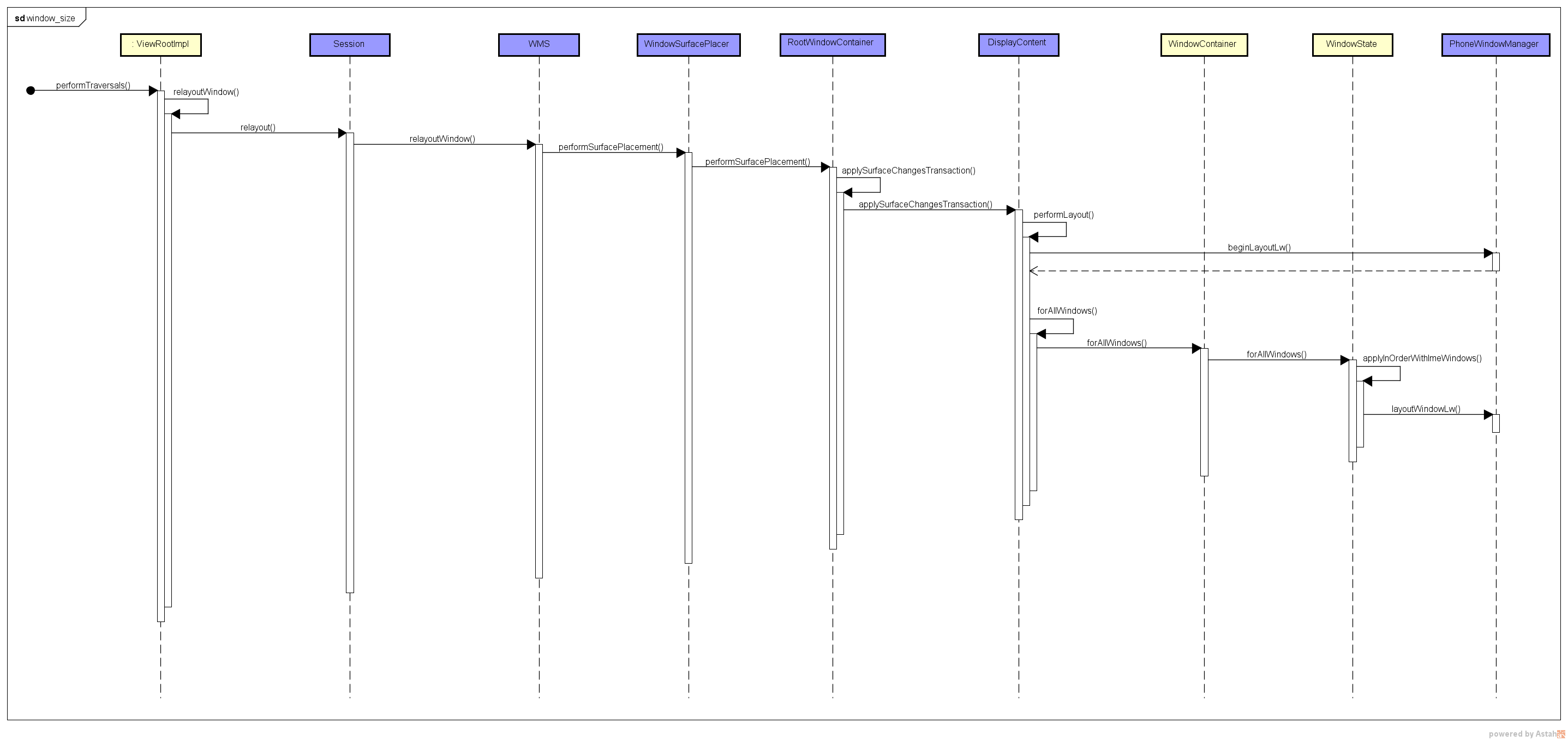APP、WMS、SurfaceFlinger
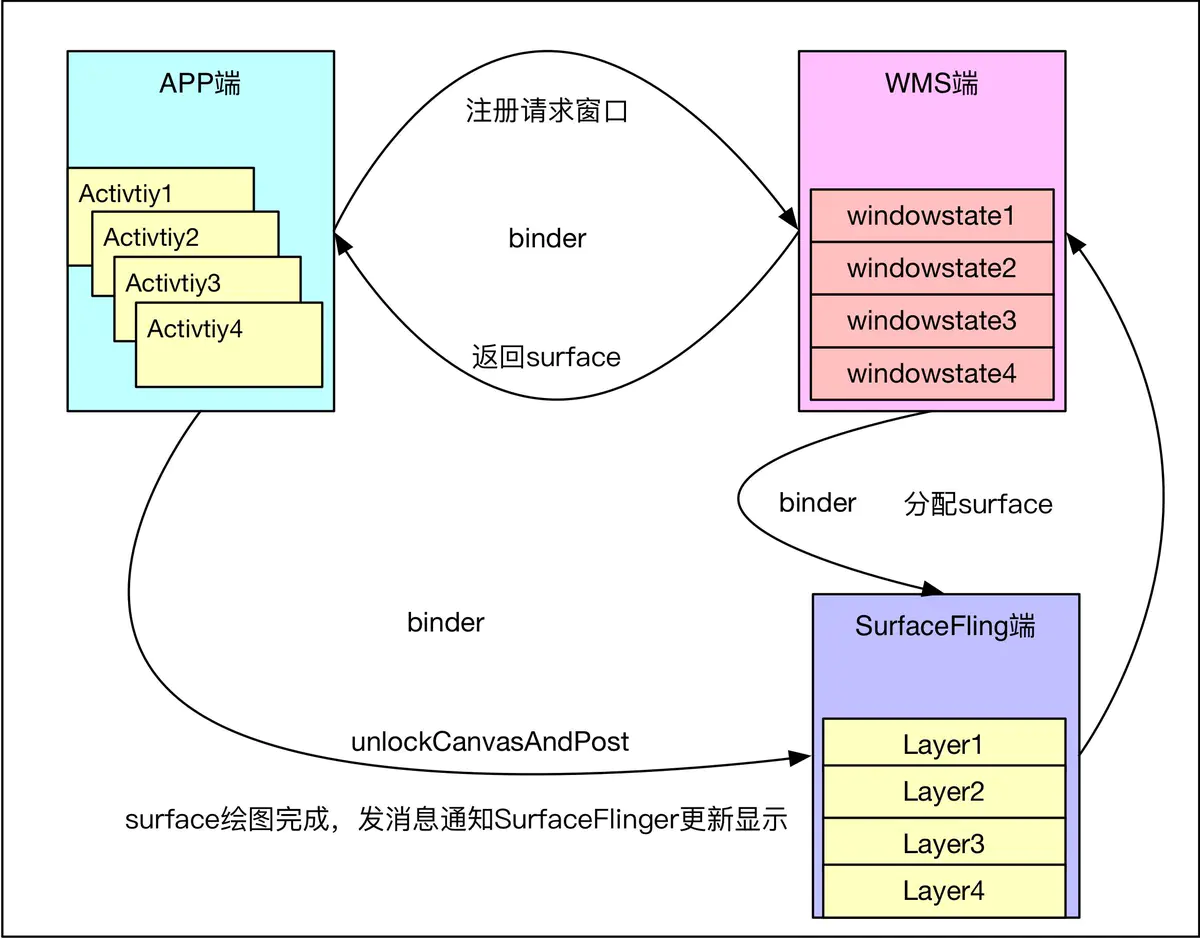
窗口组织形式
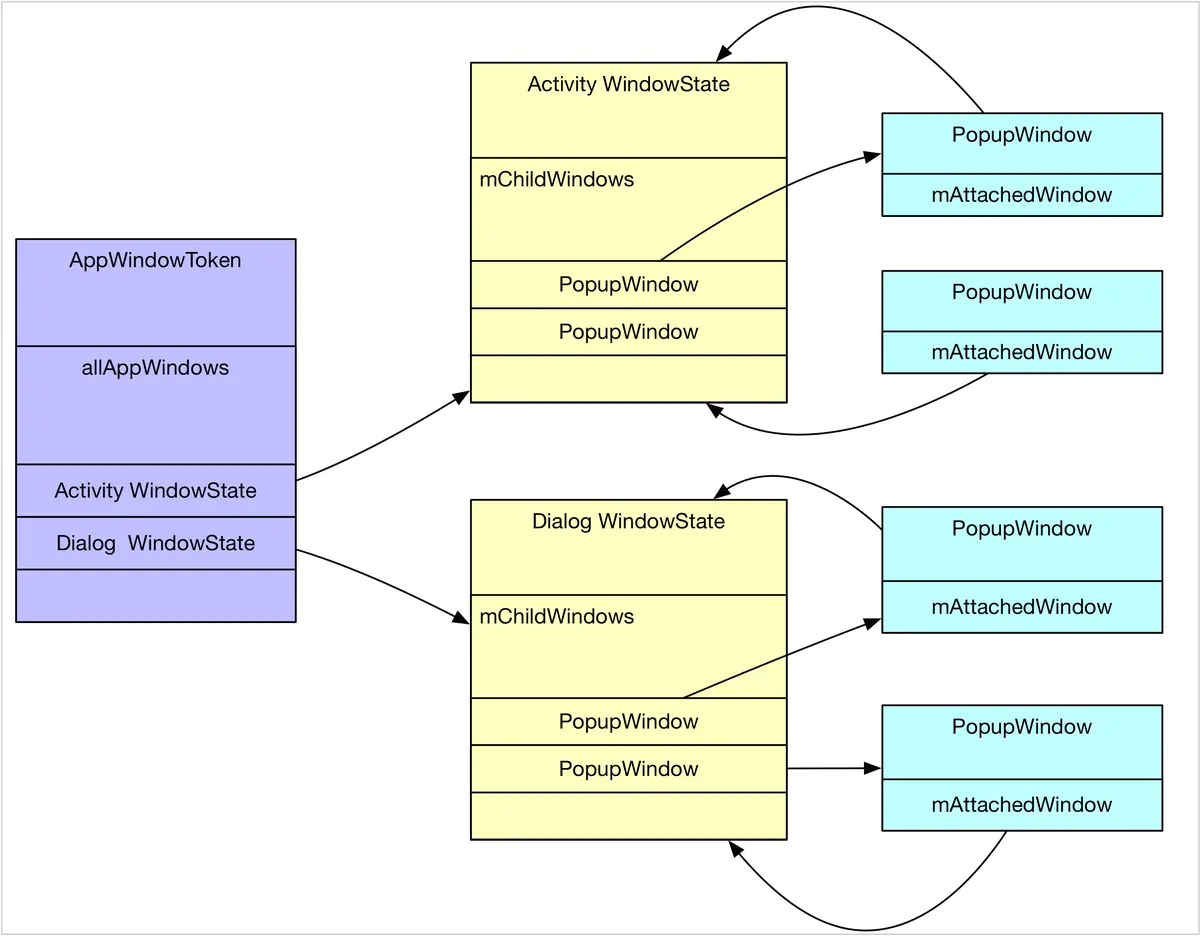
窗口数据结构

窗口的分组
public interface WindowManager extends ViewManager {
public static class LayoutParams extends ViewGroup.LayoutParams implements Parcelable {
// 窗口类型
public int type;
//-------------------------------应用窗口-------------------------------
// 开始应用程序窗口
public static final int FIRST_APPLICATION_WINDOW = 1;
// 所有程序窗口的base窗口,其他应用程序窗口都显示在它上面
public static final int TYPE_BASE_APPLICATION = 1;
// 普通应用程序窗口,token必须设置为Activity的token
public static final int TYPE_APPLICATION = 2;
// 应用程序启动时所显示的窗口
public static final int TYPE_APPLICATION_STARTING = 3;
/**
* Window type: a variation on TYPE_APPLICATION that ensures the window
* manager will wait for this window to be drawn before the app is shown.
* In multiuser systems shows only on the owning user's window.
*/
public static final int TYPE_DRAWN_APPLICATION = 4;
// 结束应用程序窗口
public static final int LAST_APPLICATION_WINDOW = 99;
//--------------------------------字窗口------------------------------
// SubWindows子窗口,子窗口的Z序和坐标空间都依赖于他们的宿主窗口
public static final int FIRST_SUB_WINDOW = 1000;
// 面板窗口,显示于宿主窗口的上层
public static final int TYPE_APPLICATION_PANEL = FIRST_SUB_WINDOW;
// 媒体窗口(例如视频),显示于宿主窗口下层
public static final int TYPE_APPLICATION_MEDIA = FIRST_SUB_WINDOW + 1;
// 应用程序窗口的子面板,显示于所有面板窗口的上层
public static final int TYPE_APPLICATION_SUB_PANEL = FIRST_SUB_WINDOW + 2;
// 对话框,类似于面板窗口,绘制类似于顶层窗口,而不是宿主的子窗口
public static final int TYPE_APPLICATION_ATTACHED_DIALOG = FIRST_SUB_WINDOW + 3;
// 媒体信息,显示在媒体层和程序窗口之间,需要实现半透明效果
public static final int TYPE_APPLICATION_MEDIA_OVERLAY = FIRST_SUB_WINDOW + 4;
/**
* Window type: a above sub-panel on top of an application window and it's
* sub-panel windows. These windows are displayed on top of their attached window
* and any {@link #TYPE_APPLICATION_SUB_PANEL} panels.
* @hide
*/
public static final int TYPE_APPLICATION_ABOVE_SUB_PANEL = FIRST_SUB_WINDOW + 5;
// 结束字窗口
public static final int LAST_SUB_WINDOW = 1999;
//--------------------------------系统窗口------------------------------
// 系统窗口
public static final int FIRST_SYSTEM_WINDOW = 2000;
// 状态栏
public static final int TYPE_STATUS_BAR = FIRST_SYSTEM_WINDOW;
// 搜索栏
public static final int TYPE_SEARCH_BAR = FIRST_SYSTEM_WINDOW+1;
/**
* Window type: phone. These are non-application windows providing
* user interaction with the phone (in particular incoming calls).
* These windows are normally placed above all applications, but behind
* the status bar.
* In multiuser systems shows on all users' windows.
* @deprecated for non-system apps. Use {@link #TYPE_APPLICATION_OVERLAY} instead.
*/
@Deprecated
public static final int TYPE_PHONE = FIRST_SYSTEM_WINDOW+2;
/**
* Window type: system window, such as low power alert. These windows
* are always on top of application windows.
* In multiuser systems shows only on the owning user's window.
* @deprecated for non-system apps. Use {@link #TYPE_APPLICATION_OVERLAY} instead.
*/
@Deprecated
public static final int TYPE_SYSTEM_ALERT = FIRST_SYSTEM_WINDOW+3;
// 锁屏
public static final int TYPE_KEYGUARD = FIRST_SYSTEM_WINDOW+4;
/**
* Window type: transient notifications.
* In multiuser systems shows only on the owning user's window.
* @deprecated for non-system apps. Use {@link #TYPE_APPLICATION_OVERLAY} instead.
*/
@Deprecated
public static final int TYPE_TOAST = FIRST_SYSTEM_WINDOW+5;
/**
* Window type: system overlay windows, which need to be displayed
* on top of everything else. These windows must not take input
* focus, or they will interfere with the keyguard.
* In multiuser systems shows only on the owning user's window.
* @deprecated for non-system apps. Use {@link #TYPE_APPLICATION_OVERLAY} instead.
*/
@Deprecated
public static final int TYPE_SYSTEM_OVERLAY = FIRST_SYSTEM_WINDOW+6;
/**
* Window type: priority phone UI, which needs to be displayed even if
* the keyguard is active. These windows must not take input
* focus, or they will interfere with the keyguard.
* In multiuser systems shows on all users' windows.
* @deprecated for non-system apps. Use {@link #TYPE_APPLICATION_OVERLAY} instead.
*/
@Deprecated
public static final int TYPE_PRIORITY_PHONE = FIRST_SYSTEM_WINDOW+7;
/**
* Window type: panel that slides out from the status bar
* In multiuser systems shows on all users' windows.
*/
public static final int TYPE_SYSTEM_DIALOG = FIRST_SYSTEM_WINDOW+8;
/**
* Window type: dialogs that the keyguard shows
* In multiuser systems shows on all users' windows.
*/
public static final int TYPE_KEYGUARD_DIALOG = FIRST_SYSTEM_WINDOW+9;
/**
* Window type: internal system error windows, appear on top of
* everything they can.
* In multiuser systems shows only on the owning user's window.
* @deprecated for non-system apps. Use {@link #TYPE_APPLICATION_OVERLAY} instead.
*/
@Deprecated
public static final int TYPE_SYSTEM_ERROR = FIRST_SYSTEM_WINDOW+10;
/**
* Window type: internal input methods windows, which appear above
* the normal UI. Application windows may be resized or panned to keep
* the input focus visible while this window is displayed.
* In multiuser systems shows only on the owning user's window.
*/
public static final int TYPE_INPUT_METHOD = FIRST_SYSTEM_WINDOW+11;
/**
* Window type: internal input methods dialog windows, which appear above
* the current input method window.
* In multiuser systems shows only on the owning user's window.
*/
public static final int TYPE_INPUT_METHOD_DIALOG= FIRST_SYSTEM_WINDOW+12;
/**
* Window type: wallpaper window, placed behind any window that wants
* to sit on top of the wallpaper.
* In multiuser systems shows only on the owning user's window.
*/
public static final int TYPE_WALLPAPER = FIRST_SYSTEM_WINDOW+13;
--------------省略--------------------
/**
* End of types of system windows.
*/
public static final int LAST_SYSTEM_WINDOW = 2999;
/**
* @hide
* Used internally when there is no suitable type available.
*/
public static final int INVALID_WINDOW_TYPE = -1;
/**
* Identifier for this window. This will usually be filled in for
* you.
*/
public IBinder token = null;
public static boolean isSystemAlertWindowType(int type) {
switch (type) {
case TYPE_PHONE:
case TYPE_PRIORITY_PHONE:
case TYPE_SYSTEM_ALERT:
case TYPE_SYSTEM_ERROR:
case TYPE_SYSTEM_OVERLAY:
case TYPE_APPLICATION_OVERLAY:
return true;
}
return false;
}
}
}
WindowContainer
class WindowContainer<E extends WindowContainer> implements Comparable<WindowContainer> {
/**
* The parent of this window container.
* For removing or setting new parent {@link #setParent} should be used, because it also
* performs configuration updates based on new parent's settings.
*/
private WindowContainer mParent = null;
// List of children for this window container. List is in z-order as the children appear on
// screen with the top-most window container at the tail of the list.
protected final WindowList<E> mChildren = new WindowList<E>();
}
窗口树
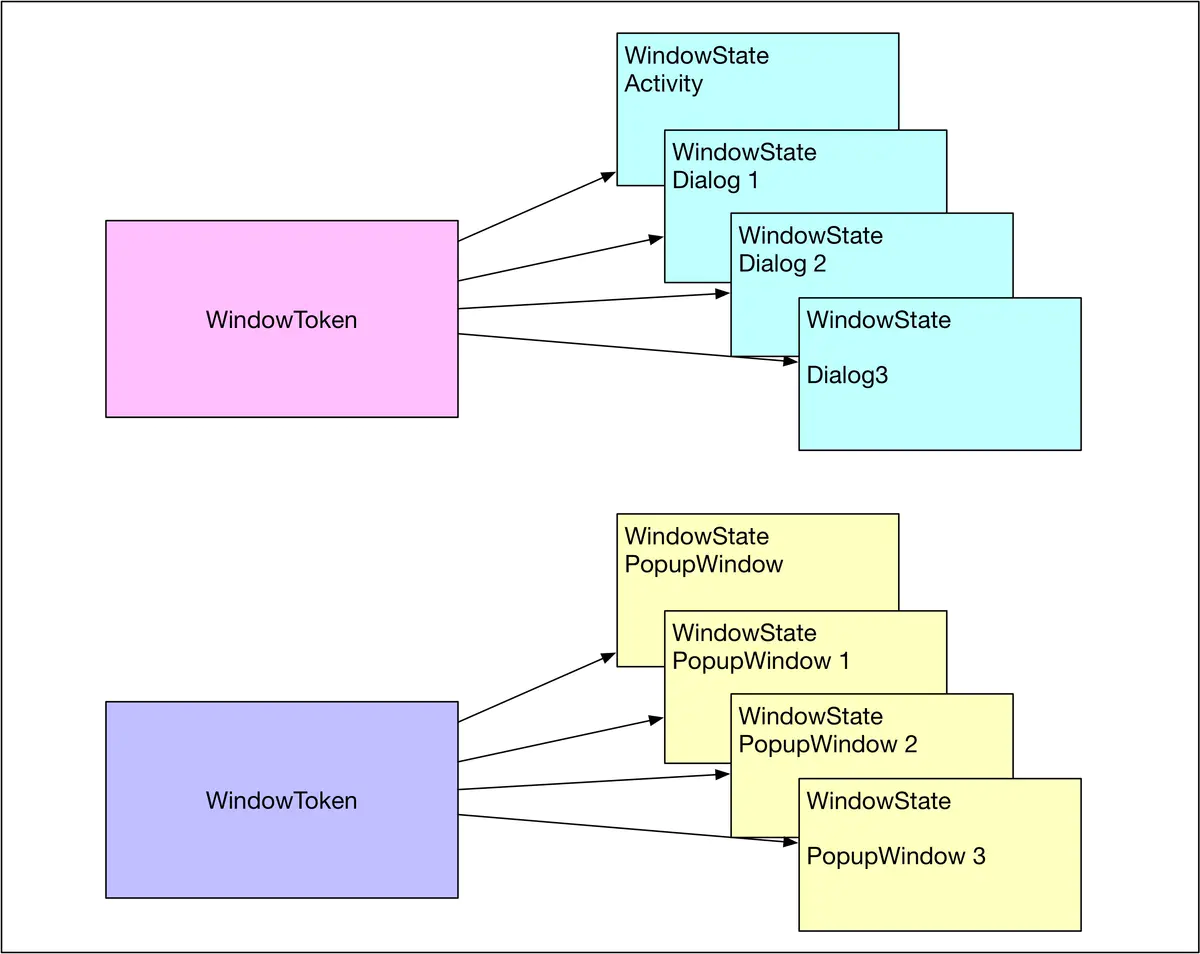
WindowState
class WindowState extends WindowContainer<WindowState> implements WindowManagerPolicy.WindowState {
static final String TAG = TAG_WITH_CLASS_NAME ? "WindowState" : TAG_WM;
// 当前WindowState对应IWindow窗口代理
final IWindow mClient;
WindowToken mToken;
// The same object as mToken if this is an app window and null for non-app windows.
AppWindowToken mAppToken;
// mAttrs.flags is tested in animation without being locked. If the bits tested are ever
// modified they will need to be locked.
final WindowManager.LayoutParams mAttrs = new WindowManager.LayoutParams();
// 标志窗口的主次序,面向的是一个窗口组
final int mBaseLayer;
// 面向单独窗口,要来标志一个窗口在一组窗口中的位置
final int mSubLayer;
// 最终Z次序的赋值
int mLayer;
}
WindowToken
class WindowToken extends WindowContainer<WindowState> {
private static final String TAG = TAG_WITH_CLASS_NAME ? "WindowToken" : TAG_WM;
// The actual token.
final IBinder token;
// The type of window this token is for, as per WindowManager.LayoutParams.
final int windowType;
}
应用窗口
android屏幕边界划分,屏幕有overscan区域、状态栏、导航栏、输入法,PhoneWindowManager定义了这些区域代表了屏幕上不同的组合
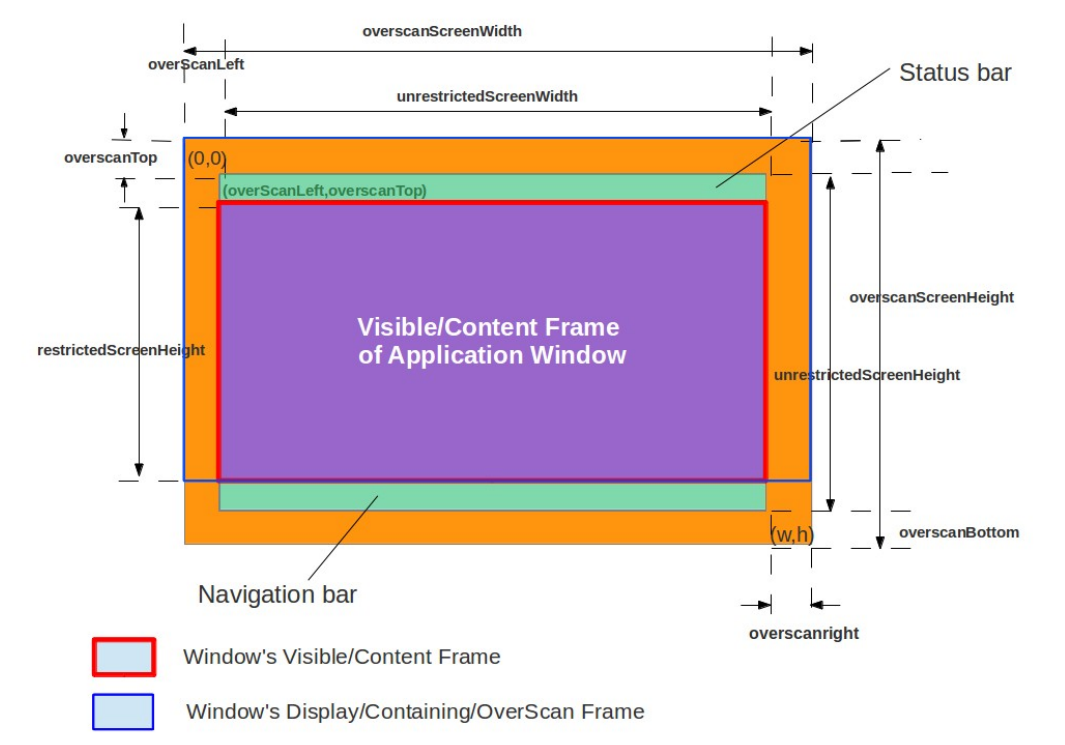
PhoneWindowManager
public final class SystemServer {
private static final String TAG = "SystemServer";
private void startOtherServices() {
wm = WindowManagerService.main(context, inputManager,
mFactoryTestMode != FactoryTest.FACTORY_TEST_LOW_LEVEL,
!mFirstBoot, mOnlyCore, new PhoneWindowManager());
}
}
public class WindowManagerService extends IWindowManager.Stub
implements Watchdog.Monitor, WindowManagerPolicy.WindowManagerFuncs {
final WindowManagerPolicy mPolicy;
private void initPolicy() {
UiThread.getHandler().runWithScissors(new Runnable() {
@Override
public void run() {
WindowManagerPolicyThread.set(Thread.currentThread(), Looper.myLooper());
mPolicy.init(mContext, WindowManagerService.this, WindowManagerService.this);
}
}, 0);
}
private WindowManagerService(Context context, InputManagerService inputManager,
boolean haveInputMethods, boolean showBootMsgs, boolean onlyCore,
WindowManagerPolicy policy) {
mPolicy = policy;
initPolicy();
}
}
public class PhoneWindowManager implements WindowManagerPolicy {
static final String TAG = "WindowManager";
WindowState mStatusBar = null;
int mStatusBarHeight;
WindowState mNavigationBar = null;
// The last window we were told about in focusChanged.
WindowState mFocusedWindow;
IApplicationToken mFocusedApp;
// 屏幕大小
int mOverscanScreenLeft, mOverscanScreenTop;
int mOverscanScreenWidth, mOverscanScreenHeight;
// Unrestricted区域,不包含overscan区域,包含导航条
int mUnrestrictedScreenLeft, mUnrestrictedScreenTop;
int mUnrestrictedScreenWidth, mUnrestrictedScreenHeight;
// RestrictedOverscan区域, 包含overscan区域,不包含导航条
int mRestrictedOverscanScreenLeft, mRestrictedOverscanScreenTop;
int mRestrictedOverscanScreenWidth, mRestrictedOverscanScreenHeight;
// Restricted区域,不包含overscan区域,不包含导航条
int mRestrictedScreenLeft, mRestrictedScreenTop;
int mRestrictedScreenWidth, mRestrictedScreenHeight;
int mSystemLeft, mSystemTop, mSystemRight, mSystemBottom;
int mStableLeft, mStableTop, mStableRight, mStableBottom;
int mStableFullscreenLeft, mStableFullscreenTop;
int mStableFullscreenRight, mStableFullscreenBottom;
int mCurLeft, mCurTop, mCurRight, mCurBottom;
int mContentLeft, mContentTop, mContentRight, mContentBottom;
int mDockLeft, mDockTop, mDockRight, mDockBottom;
@Override
public void beginLayoutLw(boolean isDefaultDisplay, int displayWidth, int displayHeight,
int displayRotation, int uiMode) {
// 初始化窗口参数
}
@Override
public void layoutWindowLw(WindowState win, WindowState attached) {
//
}
}
Activity窗口大小的计算
